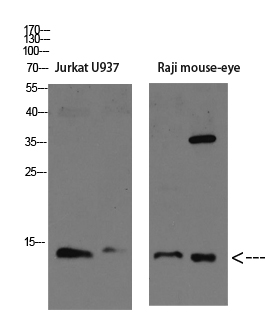TCL1 (PT0225R) rabbit mAb
- Catalog No.:YM7215
- Applications:IHC; WB;; ELISA
- Reactivity:Human;
- Target:
- TCL1
- Fields:
- >>PI3K-Akt signaling pathway
- Gene Name:
- TCL1A
- Protein Name:
- TCL1
- Human Gene Id:
- 8115
- Human Swiss Prot No:
- P56279
- Immunogen:
- Synthesized peptide derived from human TCL1 AA range:50-114
- Specificity:
- This antibody detects endogenous levels of TCL1
- Formulation:
- PBS, 50% glycerol, 0.05% Proclin 300, 0.05%BSA
- Source:
- Monoclonal, Rabbit IgG1, Kappa
- Dilution:
- IHC 1:100-500, WB 1:500-1000, ELISA 1:5000-20000
- Purification:
- Recombinant Expression and Affinity purified
- Storage Stability:
- -15°C to -25°C/1 year(Do not lower than -25°C)
- Other Name:
- Anti TCL1A;Lymphoma/leukemia, T-cell;Oncogene TCL-1;Oncogene TCL1;P14 TCL1;P14 TCL1 protein;Protein p14 TCL1;T cell leukemia 1;T cell lymphoma 1;T cell lymphoma 1A;T-cell leukemia/lymphoma 1A;T-cell leukemia/lymphoma protein 1A;TCL 1 protein;TCL1;TCL1 oncogene;TCL1 PEN;Tcl1a;TCL1A;TCL1A_HUMAN
- Molecular Weight(Da):
- 13kD
- Background:
- Overexpression of the TCL1 gene in humans has been implicated in the development of mature T cell leukemia, in which chromosomal rearrangements bring the TCL1 gene in close proximity to the T-cell antigen receptor (TCR)-alpha (MIM 186880) or TCR-beta (MIM 186930) regulatory elements (summarized by Virgilio et al., 1998 [PubMed 9520462]). In normal T cells TCL1 is expressed in CD4-/CD8- cells, but not in cells at later stages of differentiation. TCL1 functions as a coactivator of the cell survival kinase AKT (MIM 164730) (Laine et al., 2000 [PubMed 10983986]).[supplied by OMIM, Jul 2010],
- Function:
- disease:Chromosomal aberrations activating TCL1A are found in chronic T-cell leukemias (T-CLL). Translocation t(14;14)(q11;q32); translocation t(7;14)(q35;q32); inversion inv(14)(q11;q32) that involves the T-cell receptor alpha/delta locuses.,function:Enhances the phosphorylation and activation of AKT1, AKT2 and AKT3. Promotes nuclear translocation of AKT1. Enhances cell proliferation, stabilizes mitochondrial membrane potential and promotes cell survival.,similarity:Belongs to the TCL1 family.,subcellular location:Microsomal fraction.,subunit:Homodimer. Interacts with AKT1, AKT2 and AKT3 (via PH domain). Interacts with PNPT1; the interaction has no effect on PNPT1 exonuclease activity.,tissue specificity:Restricted in the T-cell lineage to immature thymocytes and activated peripheral lymphocytes. Preferentially expressed early in T- and B-lymphocyte differentiation.,
- Subcellular Location:
- Cytoplasmic, Nuclear
- Expression:
- Restricted in the T-cell lineage to immature thymocytes and activated peripheral lymphocytes. Preferentially expressed early in T- and B-lymphocyte differentiation.
- June 19-2018
- WESTERN IMMUNOBLOTTING PROTOCOL
- June 19-2018
- IMMUNOHISTOCHEMISTRY-PARAFFIN PROTOCOL
- June 19-2018
- IMMUNOFLUORESCENCE PROTOCOL
- September 08-2020
- FLOW-CYTOMEYRT-PROTOCOL
- May 20-2022
- Cell-Based ELISA│解您多样本WB检测之困扰
- July 13-2018
- CELL-BASED-ELISA-PROTOCOL-FOR-ACETYL-PROTEIN
- July 13-2018
- CELL-BASED-ELISA-PROTOCOL-FOR-PHOSPHO-PROTEIN
- July 13-2018
- Antibody-FAQs



